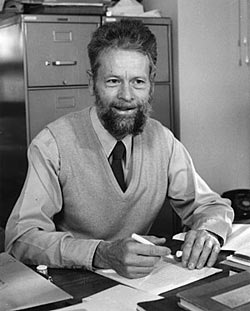Obituary
Sumner Davis
28 January 2009
 BERKELEY — Physicist Sumner P. Davis, a beloved teacher who devoted his life to the precise measurement of light emitted by molecules found in the sun and distant stars, died Dec. 31 at a care facility in El Cerrito after a brief illness. He was 84.
BERKELEY — Physicist Sumner P. Davis, a beloved teacher who devoted his life to the precise measurement of light emitted by molecules found in the sun and distant stars, died Dec. 31 at a care facility in El Cerrito after a brief illness. He was 84.
A classical optical spectroscopist, Davis for many years made laboratory measurements of the light emitted by molecules found in the sun and stars so that astronomers could recognize the molecules' wavelength signature in solar and stellar spectra. One molecule common in the sun, cyanogen (CN), occupied Davis throughout his career, although he and his students measured and analyzed many other atomic and molecular spectra using a variety of techniques, including echelle spectrometry, Fabry-Pérot interferometry and Fourier transform spectroscopy. Such spectra also reveal the quantum mechanical structure of atoms and nuclei.
Davis supervised 36 Ph.D. students and taught uncounted undergraduates during his career. He was very proud of the Distinguished Teaching Award he received from Berkeley in 1980, according to his wife, Robin Free. After his retirement in 1993, Davis returned to campus for another 10 years to direct the upper-division physics-teaching laboratory, Physics 111. He made his mark by narrating videos explaining to new students how to conduct the various experiments in the laboratory. These videos are still in use today.
Born March 18, 1924, in Burbank, Davis enrolled for one semester at UCLA before being inducted into the Army Air Corps during World War II. He trained to be a meteorologist at Pomona College, then switched to electronics and radio, eventually attending Yale and Harvard before graduating from MIT's famed Radar School. By then, however, the war had ended, and he left the Army to finish his A.B. in physics at UCLA in 1947.
After obtaining a master's degree from the University of Illinois in 1948, Davis entered graduate school at Berkeley, where in 1952 he obtained a Ph.D. for work with molecular spectroscopist Francis Jenkins, using measurements of atomic spectra to determine the nuclear spins of selenium isotopes.
He served as an instructor at MIT between 1952 and 1955, when he joined the research staff. In 1959, Jenkins invited Davis back to Berkeley to teach spectroscopy, and Davis joined the physics faculty in 1960. He was promoted to full professor in 1967.
Davis returned to Berkeley with a highly prized gift — a diffraction grating presented to him by MIT mentor George Harrison, the premier artisan of finely ruled gratings that produce the best spectra anywhere. Davis used the grating for years as part of an eschelle spectrometer to measure atomic spectra, although he also built a Fabry-Pérot interferometer to capture molecular spectra on film.
For much of his career, he studied the spectra of two-atom (diatomic) molecules of interest in astrophysics, working initially with Berkeley astronomer John Phillips. Among the molecules he discovered or cataloged in the laboratory, in stars, or in the sun were C2, FeH, CS, SH and SiC2. He authored a book, Diffraction Grating Spectographs, in 1970, as well as books on CN and C2 spectra.
After Davis moved into Fourier transform spectroscopy in 1976, he frequently traveled to the National Solar Observatory at Kitt Peak, near Tucson, to collect laboratory data using the observatory's spectrometer, then returned to Berkeley to analyze his measurements. He coauthored a book, Fourier Transform Spectrometry (2001) with Mark C. Abrams and the late James Brault.
Upon his second and final retirement from teaching in 2004, Davis moved from his home in El Cerrito to Tucson to be closer to the spectrometer. Two years later he moved back to California, settling in Carlsbad before returning to El Cerrito last year.
He was a fellow of the American Physical Society and the Optical Society of America, and a member of the American Astronomical Society and the American Association of Physics Teachers. Upon his retirement, he received the Berkeley Citation. He was a NATO Senior Fellow in Science in 1967 and twice was a visiting astronomer at the National Solar Observatory on Kitt Peak.
Davis is survived by his wife, Robin Free, of El Cerrito, and a niece, Christine King, of Morgan Hill. His first wife, Grace, whom he married in 1947, died in an automobile accident in 1989.
In lieu of flowers, Free requests that donations be made to the Physics 111 Laboratory Improvement Fund, c/o Maria Hjelm, development officer, Department of Physics, 366 LeConte Hall, Berkeley CA 94720-7300.
— Robert Sanders

